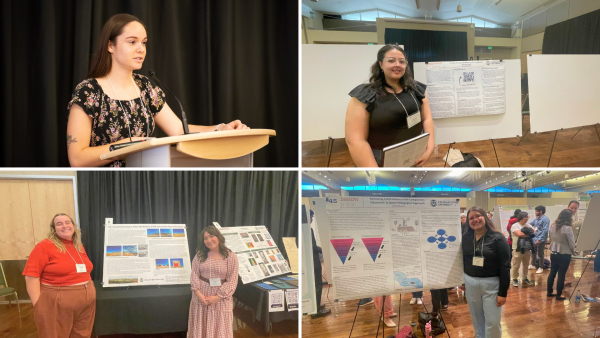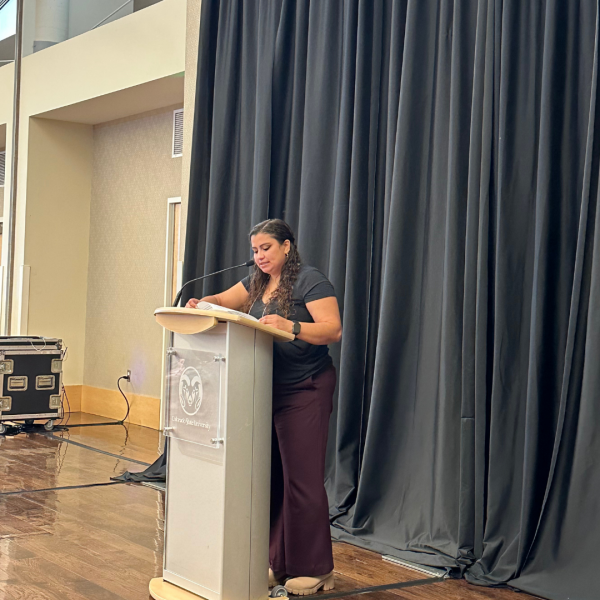Last month, several MA and MFA students in the Department of English participated in the Graduate Student Showcase and competed for more than $21,000 in scholarships while showcasing their research and creativity.
Held annually at the Lory Student Center in November, the showcase is an excellent opportunity for graduate students to hone their presentation skills and practice talking about their work for an academic audience. The all-day conference consists of poster presentations as well as creative writing readings and musical performances, culminating in an awards reception and keynote address. This year’s keynote speaker was science communicator and comedian Kasha Patel.
The English department is thrilled to congratulate the following students on their presentations and performances:
- Mia Banuelos, MA: Writing, Rhetoric and Social Change
- Lauren Furman, MFA: Fiction
- Josephine Gawtry, MFA: Poetry
- Caitlin Kahihikolo, MFA: Creative Nonfiction
- Erin Peters, MFA: Poetry
- Liz Ramirez, MFA: Creative Nonfiction
- Jamie Suto, MA: Literature

Special congrats to Liz Ramirez, who won a Top Scholar award from the College of Liberal Arts, and to Lauren Furman who received honorable mention for Distinction in Creativity from the Graduate School and Office of Vice President for Research! Read on to learn more about their award-winning work.

Liz Ramirez’s essay, “The Wilsons,” examines her family’s ancestry, whiteness, and the hybridity of identity
After digging into her family history during the COVID-19 pandemic in 2020, Ramirez, a first-year student in the MFA program’s creative nonfiction track, became drawn to the disparity in available documentation pertaining to her parents’ ancestors.
“My mother is white, and my searches for her family turned up thousands of records going back generations, some dating back to the 1600s,” Ramirez said.
“My search for my father’s family, immigrants from Mexico, hit a dead end with my paternal grandfather Sotero. I couldn’t even find where he was buried because I don’t know what year he died. I was so struck by that contrast, and confronted for the first time with what it actually means, identity-wise, to be half-white.”
Ramirez continued: “Whiteness always seemed to be metaphorically empty and neutral, giving the illusion of subtracting from ethnicity rather than adding anything of its own. I could never imagine myself as connected to or descending from my white ancestors. The experience of actually finding out who they were, what their names were, what their handwriting looked like, where they lived–it really hammered home that I am just as much a product of my mother’s heritage as my father’s. This got me thinking about the nature of hybridity and my own racial identity.”
Describing her writing process as “a recursive loop of researching, getting excited about what [she] found, going back to the draft to write about it, and returning to the research again,” Ramirez was inspired to keep writing by those who have also contended with identity in their creative work.
“Discovering some other writers who talked about their own racial hybridity—particularly our very own Harrison Candelaria Fletcher here at CSU—was incredibly generative for me and inspired me to keep working on this essay,” she said.
Lauren Furman’s short story, “Nobody and Mush” awarded honorable mention for Distinction in Creativity

Furman, a third-year graduate student studying fiction in the MFA program, said her winning story is part of her thesis collection, which currently consists of nine short stories all set in the Cayman Islands.
“I was born in Cayman, and my family lived there for nearly a decade, and in many ways, I still think of the island as home,” she said.
“My collection is a way I can reckon with my own history, as well as a way I can center this vibrant place that is so dear to me and share it with others. The collection showcases Cayman as a dynamic setting across a vast timeline, with stories spanning from the distant past into a speculative future. Many of these stories incorporate real-world aspects of Cayman’s history and culture, as well as details from my own family’s time there, while also using elements of magical realism, which is my genre of choice.”
Set roughly during the 1990s, “Nobody and Mush” blurs time and narrative convention by combining events that happen both “earlier and later in actual history.” The story centers around Luna, “an adolescent narrator navigating her family’s relationships with each other and the island, as she and her stepbrother spend a summer hunting invasive green iguanas.” As iguanas are deemed detrimental to burgeoning commercial development, Furman noted the story acts as “a turning point in the collection’s timeline, marking Cayman’s shift from something of a desert island into an international center of economic trade and tourism.”
Furman detailed that she’s been working on this story for years—she began drafting it during her undergraduate career at Vanderbilt, and credits the experience as one of the reasons she decided to pursue a Master’s degree in creative writing. The premise, she said, is born from a few kernels of truth.
“There was an actual green iguana culling that happened, although it was in the 2010s rather than the 90s,” Furman explained.
“My family learned about the culling when we visited the island and saw advertisements in the local paper saying residents could collect money for each animal they killed and delivered to the dump. When I was young, the green iguanas were everywhere (my brothers and I would try to catch them, mostly unsuccessfully), and although I understood the reasons that the population needed to be controlled, the absence of the lizards and the thought of their violent demise made me sad. The idea stuck with me, and I began writing about it as a way to work through my own nostalgia for our past lives on the island.”
After enrolling at CSU, Furman returned to the story with fresh eyes. “Once I was in the MFA program, I felt I had the skills to truly shape this idea into the story it could be. I’m so grateful to the program for giving me the tools I need to explore this part of my life and imagination through fiction.”
Both Ramirez and Furman encourage graduate students across the department to consider presenting their work at the GradShow
“This was my first time presenting, and I thought it was a very useful experience!” Furman said.
“When you first enter the MFA, one of the things you quickly learn is that being a writer means so much more than just writing. It also means being able to represent your work and find ways to share it with the world, including reading it aloud to an audience. Public speaking can be nerve-wracking, so I appreciate that the GradShow offered an opportunity to practice that skill in front of peers,” she added.
Ramirez agreed: “If you haven’t ever experienced presenting on your research or your creative project, this is a great opportunity to get some experience talking about your work, something you’ll have to do if you’re interested in being hired in an academic context. It’s great practice for a job talk someday!”
Learn more about this year’s GradShow and see the complete list of award winners via SOURCE.